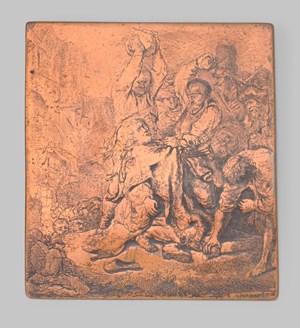
Simon Schama and Virginia E. Papaioannou have donated to the Rijksmuseum an original copper plate made by Rembrandt in 1635, depicting the stoning of Saint Stephen.
Rembrandt made 314 copper plates that served as the basis for his etchings. With this gift, there are now seven such plates in public ownership in the Netherlands, two of which are in the Rijksmuseum collection. Dr. Papaioannou taught at Oxford and Tufts Universities and is Emerita Professor of Genetics and Development at Columbia University. Sir Simon Schama has taught at Cambridge, Oxford and Harvard universities and is Professor of Art History and History at Columbia University. He is the author of numerous books on Rembrandt and the Netherlands of the 17th-century, and he is widely known for his documentaries and television programmes for the BBC.
The copper plate by Rembrandt is part of the temporary display Art in the Making, shedding light on the processes through which artists make their work, from preliminary sketch to final work of art. The display runs to 26 May 2024 in the Rijksmuseum Print Cabinets.
Rembrandt van Rijn is arguably the most famous printmaker of all time. In the period spanning 1627 to 1665 he produced no fewer than 314 copper plates to create etchings. He made the etchings by first coating a copper plate with a mixture of resin and beeswax, and then using a needle to draw into the wax, revealing the copper surface. He would then apply acid to incise the etched lines into the copper plate. The cleaned plate was then inked and covered with a sheet of paper before being passed through a printing press to transfer the image onto the paper.
The Rembrandt copper plate will be on show in the display cabinet for early-17th-century prints, alongside prints made using various states, or versions, of the etching. The prints reflect changes made over time, while the etching itself reveals how Rembrandt originally conceived the composition.
The temporary display Art in the Making encompasses all the print cabinets in the Rijksmuseum to trace the steps required to make the artworks on show. The display cabinet for the 16th century, for example, presents recently acquired preliminary studies by Adriaen de Weerdt (c. 1540-1590). Displayed alongside his prints for the first time, these drawings offer us a better understanding of how this relatively unknown master of his medium went about his work.
The Rijksmuseum also recently received six copper plates by the artist Adriaen van Ostade (1610-1685). They constitute a representative cross-section of his approximately 50 etched works. These plates are presented in the print display cabinet for the late 17th century, alongside prints made from them. They depict various aspects of rural life – at the farm, in taverns, and dancing on the village square. The artist specialised in scenes of this kind.
The print cabinet for the 18th-century presents the development of Japanese woodcuts, and the 19th-century cabinet contains a selection of daguerreotypes, the very earliest photographic images. What these two techniques have in common is the great developments they underwent in a matter of just a few centuries, thanks in part to the many experiments carried out by artists. In woodcut printing, developments mainly took place in the areas of colour and theme, while in photography the focus was on the process itself and efforts to achieve true-to-life representations – an early example being the early 19th-century microscopic image of two lice.
Main Image :The Stoning of Stephen, Rembrandt van Rijn (1606-1669), copper plate, 1635. Gift of Sir Simon Schama and dr. Virginia Eileen Papaioannou through the King Baudouin Foundation United States

ArtDependence Magazine is an international magazine covering all spheres of contemporary art, as well as modern and classical art.
ArtDependence features the latest art news, highlighting interviews with today’s most influential artists, galleries, curators, collectors, fair directors and individuals at the axis of the arts.
The magazine also covers series of articles and reviews on critical art events, new publications and other foremost happenings in the art world.
If you would like to submit events or editorial content to ArtDependence Magazine, please feel free to reach the magazine via the contact page.